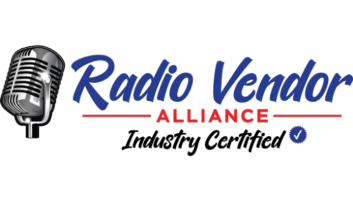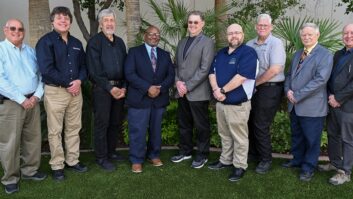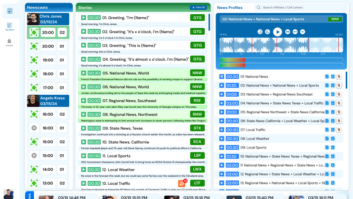
James Del of Gawker Media and Bob Garfield of WNYC/“On the Media.” Whatever the future of radio will be, it must be funded.
This is an inevitable truth, whether we’re talking about commercial or noncommercial stations; those owned by universities or those run by nonprofits; private companies or public corporations. This issue was front and center at WFMU(FM)’s third RadioVision festival last fall in New York.
RadioVision Curator Benjamen Walker describes the event as “a convergence of radio and technology.” WFMU Station Manager Ken Freedman says, “We sort of define radio a lot more widely than your typical conference, encompassing everything that a radio station should be doing, especially online.” RadioVision’s website called the event “a festival celebrating radio’s future as it takes on new forms in the digital age for the medium’s fans, tinkerers and future thinkers.”
WFMU is a scrappy and award-winning free-form station based in Jersey City, N.J. It has an international reputation, in part because it embraced live and on-demand Internet streaming early. The U.K.’s Telegraph newspaper recently named WFMU one of the best Internet radio stations and “possibly the world’s coolest.”
RELATIONSHIP
Walker said a central question for RadioVision is how a broadcaster can “stay true to yourself and find the right path.”
According to Freedman, this is about “being sustainable,” particularly if you are an independent producer, a public broadcaster or a participant in community radio. Furthermore, “Being noncommercial is becoming a more interesting question all the time.” Blurring of lines between commercial and noncommercial was evident during panels dedicated to financing.
When it comes to fundraising, “You can’t treat people like consumers. It has to be a relationship.” So says Chris Bannon, vice president of advancement for New York City public station WNYC, who shared a panel about new funding models for radio production. “We’re not sure we can make enough money on the radio alone to support what we want to do.”
The station produces “Freakonomics Radio,” based on the popular Freakonomics books by journalist Stephen Dubner and economist Steven Levitt. The program, in its fourth season, was born as a podcast and also airs on public stations.
With Internet programming, noncommercial stations are freed from FCC restrictions on underwriting, potentially opening public radio podcasts to more traditional advertising. But that doesn’t mean programmers always use that freedom.
“‘Planet Money’ will never do that because we’re deeply in NPR,” said Alex Blumberg, contributing editor for the program and a producer for “This American Life.” Bannon of WNYC agreed, saying, “Our voice is a noncommercial voice. … (While) we’re slightly looser online, we’ve decided the tone on-air is what we want to have for our sponsorships online.” Thus for example you won’t hear an ad for Stamp.com at the top of a podcast hosted by WNYC’s Brian Lehrer, even though that company is a prominent podcast and radio advertiser.

From left, Chris Bannon of WNYC, Alex Blumberg of “Planet Money” and Liz Berg of WFMU. According to Bannon, an advantage of producing “Freakonomics Radio” as a podcast is that, “We can figure out where and when (people) listen.” He said the podcast alone now reaches 3.5 million people a month, whereas the radio numbers are harder to track because the program is aired at different times in different places.
Even so, Bannon said the program loses money; so WNYC launched a membership campaign for the “Freakonomics Radio” podcast. An element of the campaign was a pre-roll announcement for the online version similar to on-air pitches during pledge drives.
Blumberg said “Planet Money” conducted a Kickstarter funding campaign to design and manufacture a T-shirt; the initial goal was $50,000 but the campaign ended up raising $580,000 for 25,000 shirts.
Yet the show raised money only for the shirts, not the program. Why? “You’re always in an awkward position at NPR when you’re fundraising because of the relationship with the individual stations,” Blumberg said. The program is a co-production between NPR and “This American Life,” and its stories air each week on the nationally syndicated “All Things Considered” and “Morning Edition.”
“The public radio stations are independent and they have their own fundraisers. So if we all raise money at the same time, it’s a mess.”
While paid subscriptions could be another option for supporting online content, Bannon said, “My hope is that we continue to give everything away for free.” Appealing to the founding principles of public broadcasting, he said, “We don’t want to deny people access from things that are publicly funded.”
NATIVE ADS
As radio broadcasters explore new sources of income, Walker and Freedman said, the experiences of other online pioneers in the area of native advertising hold lessons.
There has been growing debate in the media press about the practice. It flared when The Atlantic received stinging criticism for a native ad it ran for Scientology, an ad it subsequently pulled within a day.
Rob Walker, journalist and author of the book “Consumed,” moderated a panel and posed a provocative question about native advertising: “Is this a new opportunity for creators? Or a fresh hell of heartbreak, corruption and lies?”
Bob Garfield, co-host of NPR’s media analysis program “On the Media,” said native advertising isn’t necessarily new. There have been “things called ‘advertorials’ that sort of look like a New York Times article … (but) the Times makes sure the headline type is different … so nobody can be confused.” Such confusion, he said, is where lines are problems arise.
James Del, advertising director for Gawker.com, compared contemporary native advertising to “when a radio broadcaster reads some ad copy he or she didn’t write,” blending it seamlessly into a voice break.
It takes “the frame of the content, (like) a tweet or a post” that is similar to a site’s typical output but is sponsored by an advertiser. Walker said this “looks the same as regular content, but is labeled as sponsored content.”
Garfield said advertisers know people will click on native advertising “at a rate vastly greater than anything that looks like an ad, because they don’t know it’s an ad. They’re being tricked, duped. It’s insufficiently labeled.” The risk is not just for the audience, he warned. “Every single ad that you run that tricks the reader, you slice the golden egg, one slice at a time. The trust and credibility will be gone.”
Garfield also drew parallels between native advertising and radio underwriting.
“Weirdly enough, at least on the national level there is more of a direct connection” between funders and producers, he said. “Advertisers have more control over content than they had in commercial (radio) because you can earmark for science coverage or something like that. … That has always made me a little queasy, too.”
Speaking about the rise of native advertising, Garfield said, “The Internet creates a vast supply of content needing advertising. So the money that used to flow in to underwrite content is just drying up, disbursed upon millions of individual media. Nobody has the critical mass of advertising revenue to create quality stuff.”
This echoed a point made by Alex Blumberg of “Planet Money.” He said that with the ubiquity of free content online, “The whole world is moving to the public radio model, and I hope we all get better at it. … If you can steal anything or get it online for free, it is incumbent on the artists to make the pitch for why you should pay for it.”
Producers face questions of integrity, especially those who want to work in public and noncommercial radio, along side the ever-present need for funding. Garfield advised, “Don’t sell your creative soul along the way, or trick your listeners. The main thing is editorial independence.”
The takeaway from RadioVision is that there are many emerging models for financing production, but it’s not yet clear which ones will pay off over time.
Paul Riismandel is a 20-year veteran of community and college radio. He is co-founder and technology editor of RadioSurvivor.com.












